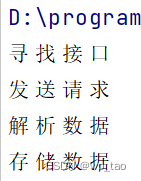-
JavaScript入门--数组
前言
JS中的数组类似于python中的列表,创建数组的方式有两种,一种是直接声明定义:
var a = [55, 12, 'python', 'hello', '11'] console.log(a)- 1
- 2
另外一种是创建对象的方法:
b = new Array(88, 'python', '你好') console.log(b)- 1
- 2
数组的操作
1、在数组的尾部添加元素
var a = [55, 12, 'python', 'hello', '11'] a.push('你好') console.log(a)- 1
- 2
- 3
结果是:[ 55, 12, ‘python’, ‘hello’, ‘11’, ‘你好’ ]。
2、删除数组尾部的元素,也就是最后一个元素
var a = [55, 12, 'python', 'hello', '11'] a.pop() console.log(a)- 1
- 2
- 3
结果是:[ 55, 12, ‘python’, ‘hello’ ]。
3、删除头部第一个元素
var a = [55, 12, 'python', 'hello', '11'] a.shift() console.log(a)- 1
- 2
- 3
结果是:[ 12, ‘python’, ‘hello’, ‘11’ ]。
4、在数组的前面添加元素
var a = [55, 12, 'python', 'hello', '11'] a.unshift('头部') console.log(a)- 1
- 2
- 3
结果是:[ ‘头部’, 55, 12, ‘python’, ‘hello’, ‘11’ ]。
小案例
以下代码会输出什么结果?
var commands = ['寻找接口', '发送请求', '解析数据', '存储数据'] while (commands.length){ command = commands.shift() console.log(command) }- 1
- 2
- 3
- 4
- 5
上述代码会依次从数组commands中由前向后取数据,并打印出来,所以会输出下图所示结果:

5、数组的翻转
reverse()方法可以将数组翻转过来。
var a = [5, 10, 'd', 'c'] a.reverse() console.log(a)- 1
- 2
- 3
以上代码输出[ ‘c’, ‘d’, 10, 5 ]。
6、数组的排序
sort()方法可以按照字母的顺序升序排序。
var a = [5, 10, 8, 1, 100] a.sort() console.log(a)- 1
- 2
- 3
上述代码的输出结果是:[ 1, 10, 100, 5, 8 ]。
7、数组的合并
var a1 = [1, 2, 3] b1 = [4, 5, 6] console.log(a1.concat(b1))- 1
- 2
- 3
上述代码的输出结果是:[ 1, 2, 3, 4, 5, 6 ]。
8、数组的切片
a = [1, 2, 3, 4, 5, 6, 7, 8] a1 = a.slice(2,4) console.log(a1)- 1
- 2
- 3
上述代码的输出结果是[ 3, 4 ]。
-
相关阅读:
[go学习笔记.第十六章.TCP编程] 2.项目-海量用户即时通讯系统
HarmonyOS应用开发者高级认证答案
.Net 6 WebAPI 使用JWT进行 授权认证配置
正式发布!Matlab配色神器TheColor
装备制造企业是否要转型智能装备后服务型公司?
含文档+PPT+源码等]精品基于PHP实现的单招志愿采集系统[包运行成功]计算机PHP毕业设计项目源码
回溯算法 | 分割字符串 | 复原IP地址 | leecode刷题笔记
shein测试开发会问些啥?
UDP和TCP的区别
带看123456
- 原文地址:https://blog.csdn.net/lyccomcn/article/details/137825898